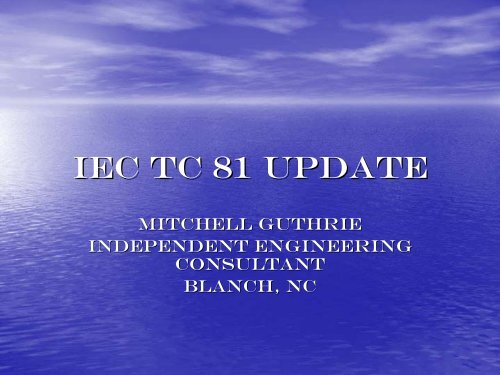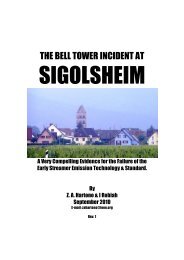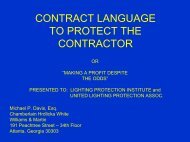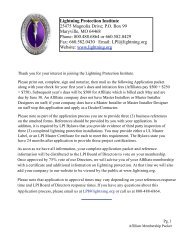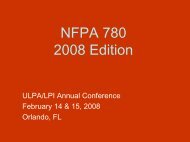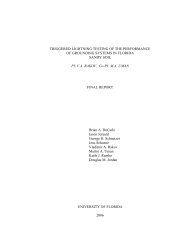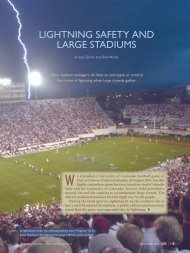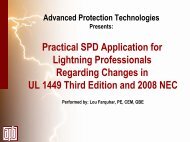IEC TC 81 Update - Lightning Protection Institute
IEC TC 81 Update - Lightning Protection Institute
IEC TC 81 Update - Lightning Protection Institute
- No tags were found...
Create successful ePaper yourself
Turn your PDF publications into a flip-book with our unique Google optimized e-Paper software.
<strong>IEC</strong> <strong>TC</strong> <strong>81</strong> <strong>Update</strong>Mitchell GuthrieIndependent EngineeringConsultantBlanch, NC
General Administration• USNC now chairs <strong>IEC</strong> Committee on<strong>Lightning</strong> <strong>Protection</strong>• No major affect on Technical AdvisoryGroup at this time
Status• Committee draft of 2 nd Edition of <strong>IEC</strong>62305 out for comments– Closing date today• New standard (<strong>IEC</strong> 62561) underdevelopment to address components– CDs out for comments– Closing date today
<strong>IEC</strong> 62305• Part 1 – General Principles• Part 2 – Risk Management• Part 3 – Measures to reduce physical damageand life hazard in a structure• Part 4 – Measures to reduce failures of electricaland electronic systems in a structure– Electrical systems include internal power distributionwiring and components
<strong>IEC</strong> 62305 Revision Issues• Part 1– Proposal to add a 3 rd current component toenvironment– Negative first return stroke– Can lead to most severe stress to equipment• Maintenance Team 8
<strong>IEC</strong> 62305 Revision Issues• Part 2– Revision in collective area calculation– Replace Risk Calculator software with morecomplete Excel spreadsheetMaintenance Team 9
<strong>IEC</strong> 62305 Revision Issues• Part 3– Resolve vertical versus horizontal electrodelength requirement– Resolve how to protect sides of tall structures– Revisit tables on materials and dimensions– Rework of Annex E
<strong>IEC</strong> 62305 Revision Issues• Part 3Resolve vertical versus horizontal electrodelength requirement– TAG conclusion to accept <strong>IEC</strong> 2:1 factorunless other info becomes available
<strong>IEC</strong> 62305 Revision Issues• Part 3Resolve how to protect sides of tall structures– 5.2.3 Air-terminations against flashes to the side of tallstructures– On structures taller than 60 m, flashes to the side may occur,especially to points, corners and edges of surfaces.– NOTE: In general the risk due to these flashes is low becauseonly a few per cent of all flashes to tall structures will be to theside and moreover their parameters are significantly lower thanthose of flashes to the top of structures. However, electrical and aelectronic equipment on walls outside structures may bedestroyed even by lightning flashes with low current peakvalues.
<strong>IEC</strong> 62305 Revision Issues• Part 3Resolve how to protect sides of tall structures– Air termination system required for top 20%structure– Rules relaxed to LPL IV (60 m sphere)– May utilize metal cladding, curtain walls, steelframe and rebar in concrete.Maintenance Team 8
<strong>IEC</strong> 62305 Revision Issues• Part 4– Rework SPD risk management– Focus on LEMP and overvoltages– Significant revision to Annex D– Focus on current sharingMaintenance Team 3
<strong>IEC</strong> 62561• Part 1 – Connection components• Part 2 – Conductors and earth electrodes• Part 3 – Isolating spark gaps• Plans in place for 3 more categories
<strong>IEC</strong> 62561• First edition CD out for comments• Based on EN 50164• Scope is to specify requirements and tests forapplicable components• USNC general comment is to ensure that itemscurrently allowed in <strong>IEC</strong> 62305 will not requiretesting• Working Group 11
Agenda• Comments on all CDs should be to TAGtoday• Working Group 11 to meet 8-118April 2008to discuss comments on <strong>IEC</strong> 62561• Maintenance Teams 3, 8, and 9 to meet14-18 18 April 2008.• Decision will be made to go to CDV afterreview of comments
Schedule• CDV - December 2008• FDIS – September 2009• Publication – December 2010• Next committee meeting?– Maybe September/October 2008


